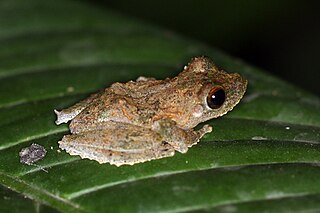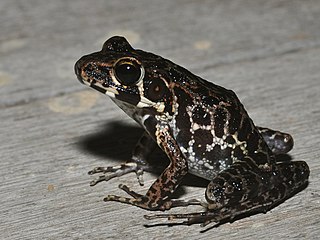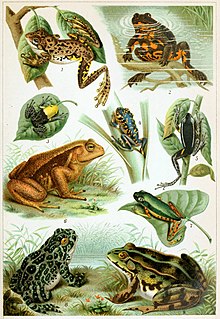
Ingerana is a genus of frogs in Dicroglossidae family. These frogs are distributed in southeastern Asia, from Nepal, northeastern India, and southwestern China to Indochina, Borneo, and the Philippines. They are sometimes known as the eastern frogs.

Microhyla berdmorei is a species of narrow-mouthed frog found in eastern India, Bangladesh, southernmost China (Yunnan), Mainland Southeast Asia as well as Borneo and Sumatra. Frogs from Bangladesh probably represent an unnamed species.
Theloderma asperum is a frog in the family Rhacophoridae. It is also known as the pied warty frog, hill garden bug-eyed frog, or somewhat informally, bird poop frog. The frog can be found in the northeastern India, Burma, China, Thailand, Cambodia, and Vietnam as well as Sumatra in Indonesia. However, because of confusion with Theloderma albopunctatus and Theloderma baibengensis, it is known with certainty from its type locality in Peninsular Malaysia.

Chaperina fusca is a species of frog in the family Microhylidae. It is monotypic within the genus Chaperina. It is found on the Malay Peninsula, in Borneo and in the Philippines. It is abundant in Borneo but uncommon on the Malay Peninsula and patchily distributed in the Philippines.
The Larut Hills rice frog is a species of frog in the family Microhylidae. It is found in Peninsular Malaysia; records from Thailand and elsewhere probably refer to other species. Its natural habitats are evergreen submontane and montane rainforests. It lives on the forest floor and in puddles and breeds in temporary pools. It is locally threatened by habitat loss.

The painted chorus frog is a species of frog in the family Microhylidae. It is found in northeast India, Myanmar, southern China, Hong Kong, Taiwan, Thailand, Cambodia, Laos, Vietnam, Peninsular Malaysia, and Singapore. Its natural habitats are subtropical or tropical moist lowland forest, subtropical or tropical moist montane forest, subtropical or tropical moist shrubland, swamps, intermittent freshwater marshes, arable land, plantations, rural gardens, ponds, open excavations, and irrigated land. It is not considered threatened by the IUCN.
Microhyla superciliaris is a species of frog in the family Microhylidae. It is found in Peninsular Malaysia and Sumatra (Indonesia). Its type locality is Batu Caves, which have given it its common name, Batu Cave rice frog. The type locality is a limestone crag area surrounded by lowland forest. In Sumatra it is found in forested areas. Breeding presumably takes place is slow-flowing rivers.
Alcalus baluensis is a species of frog in the family Ceratobatrachidae. It is endemic to northern and western Borneo and found in Brunei, Indonesia, and Malaysia. Its common name is Balu eastern frog or dwarf mountain frog. It was placed in Dicroglossidae before being transferred to Ceratobatrachidae in 2015.

Ingerana tasanae is a species of frog in the Dicroglossidae family. It is found in Western and Southern (=Peninsular) Thailand; its range likely extends to Myanmar but it has not yet been recorded there. Its natural habitats are primary rainforests near streams. It is threatened by habitat loss.

Blyth's river frog, Blyth's frog, giant Asian river frog, or (ambiguously) giant frog, Limnonectes blythii, is a species of frog in the Dicroglossidae family found from Myanmar through western Thailand and the Malay Peninsula to Sumatra and Borneo (Indonesia). Earlier records from Laos and Vietnam are considered misidentifications.

Limnonectes doriae is a species of frog in the family Dicroglossidae found in the Southeast Asia.

Amolops larutensis is a species of frog in the family Ranidae that is found in the Malay Peninsula from southernmost Thailand to Malaysia; records further north probably represent A. panhai.
The Malesian frog, Malaysian river frog, Malaysian peat frog, or peat swamp frog is a species of frog in the Dicroglossidae family. It is found on the Malay Peninsula, Sumatra, Java, Borneo, and a range of islands on the Sunda Shelf . Its natural habitats are shallow, gentle streams and nearby swampy areas including peat swamps, very flat alluvial forests, and overgrown plantations. It is becoming rare due to habitat loss (deforestation), and to a lesser extent, exploitation.

Ingerana borealis, or the northern frog, also Rotung oriental frog and many other common names, is a species of frog in the Dicroglossidae family. It is found in Bangladesh, Bhutan, northeastern India, Tibet, Nepal, and western Myanmar.
Ingerana charlesdarwini is a species of frogs in the family Dicroglossidae. It is endemic to the Andaman Islands, India, and is known from the South Andaman Island, Long Island, and North Andaman Island.

The frilled tree frog, rough-armed tree frog, or Southeast Asian tree frog is a species of frog in the family Rhacophoridae found in Brunei, Cambodia, India, Indonesia, Malaysia, Myanmar, the Philippines, Thailand, and Vietnam. Its natural habitats are subtropical or tropical moist lowland forest, subtropical or tropical swamps, subtropical or tropical moist shrubland, rivers, swamps, freshwater marshes, and intermittent freshwater marshes. It is threatened by habitat loss.
Robinson's tree frog is a species of frog in the family Rhacophoridae found in Malaysia and Thailand. Its natural habitats are subtropical or tropical moist lowland forests and intermittent freshwater marshes. It is threatened by habitat loss.

Microhyla fissipes is a microhylid frog from East and Southeast Asia, from southern and central China and Taiwan to the Malay Peninsula. It was previously considered to be the same species as Microhyla ornata of South Asia; thus the common names ornate narrow-mouthed frog or ornamented pygmy frog can refer to either species.

Hylarana baramica, the Baram River frog, brown marsh frog, or masked rough-sided frog, is a species of true frog in the genus Hylarana. It is found in Brunei, Indonesia, Malaysia, Singapore, and the extreme south Thailand. Its type locality is the Baram River in Sarawak, Malaysia, giving it one of its common names. Its natural habitats are tropical moist lowland forests and swamps. It is not considered threatened by the IUCN.

Amolops panhai is a species of true frogs that can be found in western and peninsular Thailand and in eastern Myanmar. It is associated with streams and waterfalls in moist lowland forests.
















